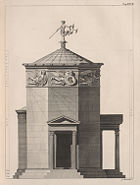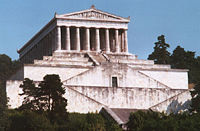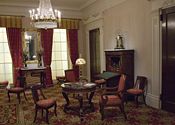Greek Revival architecture

The Greek Revival was an architectural movement of the late eighteenth and early nineteenth centuries, predominantly in northern Europe and in the United States it was hugely popular. A product of Hellenism, it may be looked upon as the last phase in the development of Neoclassical architecture. With a new found access to Greece archaeologist-architects of the period studied the Doric and Ionic movement, examples of which can be found in Russia, Poland, Lithuania, and Finland (where the assembly of Greek buildings in Helsinki city centre is particularly notable). Yet in each country it touched, the style was looked on as the expression of local nationalism and civic virtue, especially in Germany and America, where the idiom was regarded as free from any ecclesiastical or aristocratic associations. The term Greek revival was first used by Charles Robert Cockerell in a lecture he gave as Professor of Architecture to the Royal Academy in 1842. The term was indicative of how highly self-conscious these practitioners of the style were who knew that they had created a new mode of architecture. The taste for all things Greek in furniture and interior design was at its peak by the beginning of the nineteenth century, when the designs of Thomas Hope had influenced a number of decorative styles known variously as Neoclassical, Empire, Russian Empire, and Regency. Greek Revival architecture took a different course in a number of countries, lasting up till the Civil War in America (1860s) and even later in Scotland. The style was also exported to Greece under the first two (German and Danish) kings of the newly independent nation.
Contents |
Britain

Despite the unbounded prestige of ancient Greece amongst the educated elite of Europe, there was little to no direct knowledge of that civilization before the middle of the 18th century. The monuments of Greek antiquity were known chiefly from Pausanias and other literary sources. Visiting Ottoman Greece was a difficult and dangerous business prior to the period of stagnation beginning with the Great Turkish War. Few Grand Tourists called on Athens during the first half of the 18th century, and none made any significant study of the architectural ruins. It would take until the expedition funded by the Society of Dilettanti of 1751 by James Stuart and Nicholas Revett before serious archaeological enquiry began in earnest. Stuart and Revett's findings, published as The Antiquities of Athens (first vol. 1762, vol. 5, 1816), along with Julien-David Le Roy's Ruines des plus beaux monuments de la Grèce (1758) were the first accurate surveys of ancient Greek architecture. Intellectual curiosty quickly led to a desire to emulate, so Stuart was commissioned after his return from Greece by George Lyttelton to produce the first Greek building in England, the garden temple at Hagley Hall (1758-9)[1]. A number of British architects in the second half of the century took up the expressive challenge of the Doric from their aristocratic patrons, including Joseph Bonomi and John Soane, but it was to remain the private enthusiasm of connoisseurs up to the first decade of the nineteenth century.

Seen in its wider social context, Greek Revival architecture sounded a new note of sobriety and restraint in public buildings in Britain around 1800 as an assertion of nationalism attendant on the Act of Union, the Napoleonic wars, and the clamour for political reform. It was to be William Wilkins's winning design for the public competition for Downing College that announced the Greek style was to be the dominant idiom in architecture. Wilkins and Robert Smirke went on to build some of the most important buildings of the era, including the Theatre Royal, Covent Garden (1808-9), the General Post Office (1824-9), and the British Museum (1823-48), Wilkins University College London (1826-30), and the National Gallery (1832-8). In Scotland the style was avidly adopted by William Henry Playfair, Thomas Hamilton, and Charles Robert Cockerell, who severally and jointly contributed to the massive expansion of Edinburgh's New Town, including the Calton Hill development and the Moray estate. Such was the popularity of the Doric in Edinburgh that the city now enjoys a striking visual uniformity, and as such is sometimes whimsically referred to as the Athens of the North.
If it is tempting to see the Greek revival as the expression of Regency authoritarianism, then the changing conditions of life in Britain made Doric the loser of the Battle of the Styles, dramatically symbolized by the selection of Barry's Gothic design for the Palace of Westminster in 1836. Nevertheless, Greek continued to be in favour in Scotland well into the 1870s in the singular figure of Alexander Thomson.
Germany and France

In Germany, the Greek revival is predominantly found in two centres, Berlin and Munich. In both locales, Doric was the court style rather than a popular movement, and was heavily patronized by Frederick William II and Ludwig I as the expression of their desires for their respective seats to become the capital of Germany. The earliest Greek building was the Brandenburg Gate (1788-91) by Carl Gotthard Langhans, who modelled it on the Propylaea. Ten years after the death of Frederick the Great, the Berlin Akademie initiated a competition for a monument to the king that would promote “morality and patriotism."

Friedrich Gilly’s unexecuted design for a temple raised above the Leipziger Platz caught the tenor of high idealism that the Germans sought in Greek architecture and was enormously influential on Karl Friedrich Schinkel and Leo von Klenze. Schinkel was in a position to stamp his mark on Berlin after the catastrophe of the French occupation ended in 1813; his work on what is now the Altes Museum, Schauspielhaus, and the Neue Wache transformed that city. Similarly, in Munich von Klenze’s Glyptothek and Walhalla were the fulfillment of Gilly’s vision of an orderly and moral German world.
By comparison, the Greek revival in France was never popular with either the State or the public. What little there is started with Charles de Wailly’s crypt in the church of St Leu-St Gilles (1773-80), and Claude Nicolas Ledoux’s Barriere des Bonshommes (1785-9). First-hand evidence of Greek architecture was of very little importance to the French, due to the influence of Marc-Antoine Laugier’s doctrines that sought to discern the principles of the Greeks instead of their mere practices. It would take until Laboustre’s Neo-Grec of the second Empire for the Greek revival to flower briefly in France.
North America

Thomas Jefferson owned a copy of the first volume of The Antiquities of Athens,[2] and though he never practiced in the style Jefferson was to prove instrumental in introducing Greek Revival architecture to the United States. In 1803, Benjamin Latrobe was appointed by Jefferson as surveyor of public building in the United States, Latrobe went on to design a number of important public buildings in Washington, D.C. and Philadelphia, including work on the United States Capitol and the Bank of Pennsylvania.[3]

Latrobe's design for the Capitol was an imaginative interpretation of the classical orders not constrained by historical precedent, incorporating American motifs such as corncobs and tobacco leaves into his capitals. This idiosyncratic approach was to become typical of the American attitude to Greek detailing. His overall plan for the Capitol did not survive, though much of his interiors do. He also did notable work on the Supreme Court interior (1806-7) and his masterpiece, the Basilica of the Assumption of the Virgin Mary, Baltimore (1805-21). Even as he claimed that “I am a bigoted Greek in the condemnation of the Roman architecture…,” he did not seek to rigidly impose Greek forms, stating that “[o]ur religion requires a church wholly different from the temple, our legislative assemblies and our courts of justice, buildings of entirely different principles from their basilicas; and our amusements could not possibly be performed in their theatres or amphitheatres.”[4] Latrobe’s circle of junior colleagues would prove to be an informal school of Greek revivalists, and it was his influence that was to shape the next generation of American architects.

The second phase in the development of American Greek revival saw the pupils of Latrobe create a monumental national style under the patronage of banker and hellenophile Nicholas Biddle, including such works as the Second Bank of the United States by William Strickland (1824), Biddle’s home "Andalusia" by Thomas U. Walter (1835-1836), and Girard College also by Walter (1833-47). New York saw the construction (1833) of the row of Greek temples at Sailors' Snug Harbor. At the same time, the popular appetite for the Greek was sustained by architectural pattern books, the most important of which was Asher Benjamin’s The Practical House Carpenter (1830). This guide helped create the proliferation of Greek homes seen especially in northern New York State and the Western Reserves of Ohio. From the period of about 1820 to 1850, the Greek Revival style dominated the United States and could be found as far west as Springfield, Illinois.
Other notable American architects to use Greek Revival designs included Latrobe's student, Robert Mills who designed the Washington Monument, as well as George Hadfield, and Gabriel Manigault.[3]
In Canada, Montreal architect John Ostell designed a number of prominent Greek Revival Buildings, including the first building on the McGill University campus and Montreal's original Custom House, now part of the Pointe-à-Callière Museum. The Toronto Street Post Office, completed in 1853, is another Canadian example.
Polychromy

- See also: Polychrome
The discovery that the Greeks had painted their temples had a profound influence on the later development of the style. The archaeological dig at Aegina and Bassae in 1811-12 by Cockerell, Otto Magnus von Stackelberg, and Karl Haller von Hallerstein had disinterred painted fragments of masonry daubed with impermanent colours. This revelation was a direct contradiction of Winckelmann’s notion of the Greek temple as timeless, fixed, and pure in its whiteness. In 1823, Samuel Angell discovered the coloured metopes of Temple C at Selinunte, Sicily and published them in 1826. The French architect Jacques Ignace Hittorff witnessed the exhibition of Angell’s find and endeavoured to excavate Temple B at Selinus. His imaginative reconstructions of this temple were exhibited in Rome and Paris in 1824 and he went on to publish these as Architecture polychrome chez les Grecs (1830) and later in Restitution du Temple d'Empedocle a Selinote (1851). The controversy was to inspire von Klenze’s Aegina room at the Munich Glyptothek of 1830, the first of his many speculative reconstructions of Greek colour.
Hittorff lectured in Paris in 1829-1830, that Greek temples had originally been painted ochre yellow, with the moulding and sculptural details in red, blue, green, and gold. While this may or may not have been the case with older wooden or plain stone temples, it was definitely not the case with the more luxurious marble temples, where color was used sparingly to accentuate architectural highlights. Similarly, Henri Labrouste proposed a reconstruction of the temples at Paestum to the Academie des Beaux-Arts in 1829, decked out in startling colour, inverting the accepted chronology of the three Doric temples, thereby implying that the development of the Greek orders did not increase in formal complexity over time, i.e., the evolution from Doric to Corinthian was not inexorable. Both events were to cause a minor scandal. The emerging understanding that Greek art was subject to changing forces of environment and culture was a direct assault on the architectural rationalism of the day.
Influence
With the rise of architectural historicism in the mid-nineteenth century it is no longer possible to speak of a Greek revival movement, where the Doric is employed it is as another self-consciously anachronizing style. The San Francisco mint (completed 1874) is a case in point. Yet Greek culture and Greek design motifs continued to exert a powerful hold on late Victorian imagination and beyond. Peter Behrens’s Haus Wiegund (1911-12), for example, echos the austere classicism of Gilly and Schinkel. Further north we find a resurgent interest in rationalism dressed in the neoclassical style; Nordic Classicism. If the idiom has fallen out of favour since World War II it is thanks to its association, rightly or wrongly, with the pastiche classicism of Albert Speer which still provokes controversy as witnessed in Léon Krier’s provocative essay “Krier on Speer".[5]
Notes
- ↑ Though Giles Worsley detects the first Grecian influenced architectural element in the windows of Nuneham Park from 1756, see Giles Worsley, The First Greek Revival Architecture, The Burlington Magazine, Vol. 127, No. 985 (Apr., 1985), pp. 226-229
- ↑ Hamlin op. cit. p. 339.
- ↑ 3.0 3.1 Federal Writers' Project (1937). Washington, City and Capital: Federal Writers' Project. Works Progress Administration / United States Government Printing Office. pp. p. 126.
- ↑ The Journal of Latrobe quoted in Hamlin, Greek Revival.., p. 36 (Dover Edition).
- ↑ Krier on Speer. Architectural Review, vol. 173, 1983, pp. 33-38.
Primary sources
- Jacob Spon Voyage d'Italie, de Dalmatie, de Grèce et du Levant 1678
- George Wheler Journey into Greece 1682
- Richard Pococke A Description of the East and Some Other Countries 1743-5
- R. Dalton Antiquities and Views in Greece and Egypt 1751
- Comte de Caylus Recueil d'antiquités 1752-67
- Marc-Antoine Laugier Essai sur l'architecture 1753
- J.J. Winkelmann Gedanken uber die Nachahmung der griechischen Werke in der Malerei und Bildhauerkunst" 1755
- J D LeRoy Les Ruines des plus beaux monuments de la Grèce 1758
- James Stuart and Nicholas Revett The Antiquities of Athens 1762-1816
- J.J. Winkelmann Anmerkungen uber die Baukunst der alten Tempel zu Girgenti in Sicilien 1762
- J.J. Winkelmann Geschichte der Kunst des Alterthums 1764
- Thomas Major The ruins of Paestum 1768
- Stephen Riou The Grecian Orders 1768
- R. Chandler et al. Ionian Antiquities 1768-1881
- G. B. Piranesi Differentes vues...de Pesto 1778
- J.J. Barthelemy Voyage du jeune Anarcharsis en Grèce dans le milieu du quatrième siecle avant l'ère vulgaire 1787
- William Wilkins The Antiquities of Magna Grecia 1807
- Leo von Klenze Der Tempel des olympischen Jupiter zu Agrigent 1821
|
References
- Greek Revival Architecture in America, Talbot Hamlin, OUP, 1944.
- Greek Revival America, Roger G. Kennedy, 1989.
- Greek Revival America? Reflections on uses and functions of antique architectural patterns in American architecture between 1760-1860, Christoph Hoecker, in: Hephaistos - New approaches in Classical Archaeology and related fields vol. 15, 1997, pp. 197-241.
- The Greek Revival, J. Mordaunt Cook, 1972.
- The Sources of Greek Revival Architecture, Dora Wiebenson, 1969.
- Study of Greek Revival Architecture in the Seneca and Cayuga Lake Regions, by Clifford H. Ruffner, Jr.
|
|||||||||||||||||